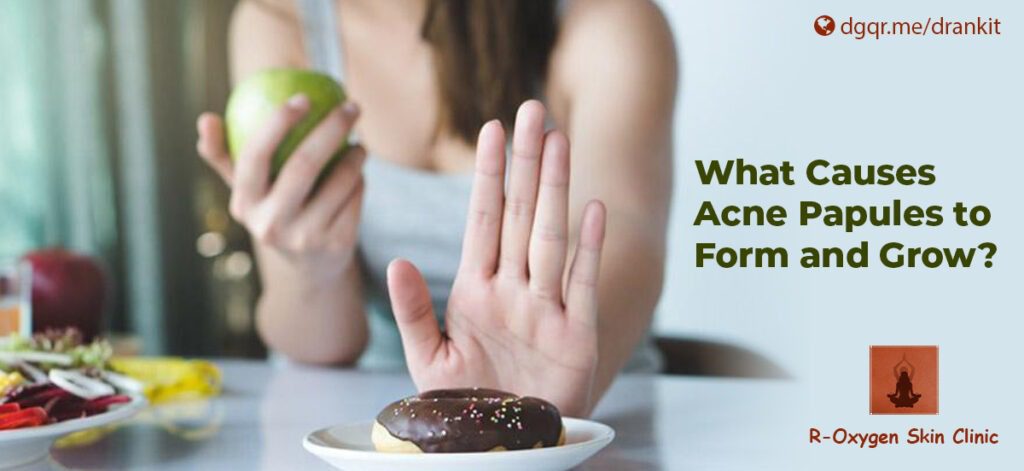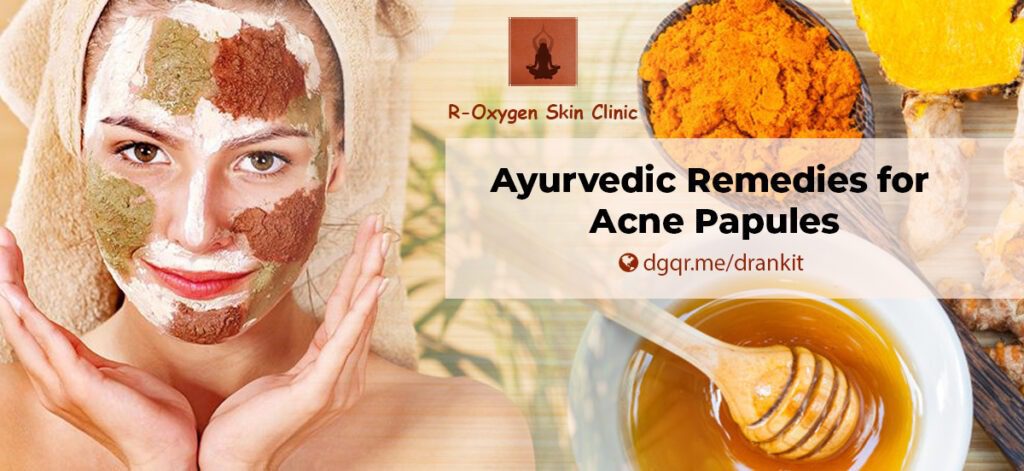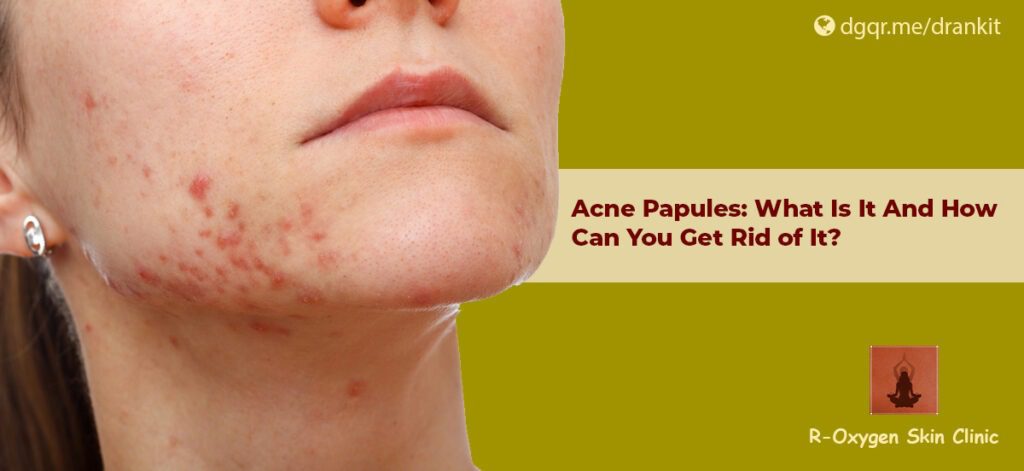Welcome again! It is very exciting to see you back on this blog series related to skin problems. So far, we’ve covered quite a few topics mentioned below and “Acne Papules” is going to be our last topic of the series.
- Sebaceous
- Whiteheads
- Blackheads
- Acne Papules
Skin is the body’s largest organ and it is also the one most exposed to outside elements. That’s why it can be susceptible to many skin conditions, such as acne, psoriasis, dermatitis, eczema and even cancer. One common skin condition that affects both adults and kids alike is acne.
Acne occurs when the oil glands in the skin produce too much sebum or when bacteria infects these oil glands. The excess sebum combined with bacteria forms a plug which blocks your skin pores resulting in an acne lesion. These lesions are what we know as pimples or zits. Acne lesions can be either open or closed comedones which are also known as blackheads or whiteheads, Papules, pustules etc.
With this, let’s start with Papules and Pustules in this acne series.
What are Acne Papules and Causes of Papules?
Acne is often characterized by red patches of skin that are usually caused by clogged pores. Papules are acne lesions that are red, raised bumps on the surface of the skin. They can be tender to the touch and vary in size (from 1 mm to 5 mm), but they tend to be smaller than pustules or nodules.
The most common cause of papular acne is hormonal imbalance, which leads to an overproduction of sebum, or a build-up of bacteria called Propionibacterium acnes, which thrive in oily environments. Other common causes of papules and pustules include acne, skin conditions, heavy sweating or sebum production, skin injuries, bacterial infections, viral infections, insect bites or stings, and skin allergies.
Difference between Papule and Pustule
A papule is a small raised bump on the skin that is red in color. They are often found at the site of an infection. A pustule is a pus-filled, pimple-like lesion. It is very similar to a papule, but pus can be squeezed out of it. Papules are different from pustules in that they are not filled with pus and they are not as inflamed as pustules.

What Causes Acne Papules to Form and Grow?
Acne papules form as a result of the sebaceous glands becoming clogged with oils and dead skin cells. These glands are located under the surface of the skin and secrete a natural oil called sebum.
The sebum contains a chemical called lipids, which can clog pores and cause acne to form. If this happens, bacteria is formed which causes inflammation. The inflammation is what causes the acne to appear red, swollen, and irritated.
There are many different factors that cause acne papules to form as well as many ways to treat them. They can be caused by excess oil and sebum secretions or bacterial infections which may lead to scarring if not properly treated by a doctor.
Topical Treatments for Acne Papules
There are various topical treatments for acne papules. These topical treatments can be used to reduce the visibility of acne papules or they can be used to get rid of them. These topical treatments include:
– Topical antibiotics: Antibiotics can be applied topically and may help with acne papules. The antibiotic kills the bacteria that causes acne and this helps with inflammation that may result in the skin.
– Topical retinoids: Topical retinoids work by decreasing oil production and also decreasing inflammation around the skin’s pores. This will help keep your skin looking healthy and moisturized while allowing for less bacteria to grow on it which leads to less breakouts.
– Benzoyl peroxide: Benzoyl peroxide is a chemical that helps remove acne-causing bacteria while also reducing inflammation and redness.
Natural Remedies for Acne Papules
Acne is a skin condition that affects the oil glands of the skin and hair follicles. It can lead to development of acne lesions such as blackheads, whiteheads and pimples. Acne is caused by an accumulation of sebum and keratin at the skin’s surface.
There are many natural remedies for acne papules that can be used to treat this condition. Some of these remedies include:
– The first remedy is to consume a lot of fluids and drink at least 8 glasses of water every day. This will help detoxify the body and give you a radiant skin.
– Another remedy is to use castor oil on the papules, which helps in reducing the inflammation and also helps with blood circulation.
– The third remedy is to eat fresh fruits and vegetables daily for their high antioxidant content, which does wonders for your skin health as well as moods.
– Clearing away dead skin cells with a gentle exfoliator such as tea tree oil or lavender oil.
– Cleaning your face twice daily with soap and water to remove dirt, grime and excess oils from your face.
– Applying ice packs or taking a cold shower on your face to temporarily reduce inflammation.
– Using apple cider vinegar or lemon juice on Acne Papules can help to stop the spread of bacteria that causes them and reduce redness and swelling. In addition, they can help to clear up the blackheads as well as reduce inflammation.

Ayurvedic Remedies for Acne Papules
Garlic
Garlic is a wonderful remedy for acne. Crush a few garlic cloves, and add 1 teaspoon of honey to make a paste. Apply this paste on the acne for 20-30 minutes and then wash it off.
Papaya
Papaya is rich in Vitamin A and is an excellent remedy for acne. Take a ripe papaya and mash it up. Apply this pulp on the acne for 20-30 minutes and then wash it
Turmeric Juice
Turmeric juice alleviates acne and makes your skin tone even. It is an excellent cleansing agent and has cleansing properties that can help get rid of acne and other skin problems. It also has anti-inflammatory and antioxidant properties that can bring down the redness and inflammation in the skin.
Lemon juice
Lemon juice is a great natural remedy for acne. It has antibacterial properties that can help kill bacteria and reduce inflammation. Plus, the vitamin C in lemon juice helps clear acne-causing skin cells. To use lemon juice as a natural remedy for acne, simply squeeze the juice out of one lemon and apply it to your face using a cotton ball. Leave the lemon juice on your face for about 10 minutes or until it dries. Rinse your face.
Try these at-home remedies, if you have mild or moderate acne. If you have serious acne caused by hormones it’s probably time to visit R-Oxygen Skin Clinic for personalized treatment.
What Not To Do When You Have Acne Papules?
– Do not pop or squeeze acne papules to remove pus from them. This can cause scarring and irreversible damage to the skin cells around the area where you popped or squeezed it.
– Avoid using benzoyl peroxide or salicylic acid if you have very sensitive skin due to these chemicals being harsh on sensitive skin types.
Conclusion
Although it might be tempting to pick or pop your blemishes it’s important to avoid doing so. Using overly abrasive products will lead to irritation and inflammation. This irritability can also scar the skin, making it harder to heal.
If you’re looking for custom & personalised ayurveda treatment for acne, book your online appointment today!
